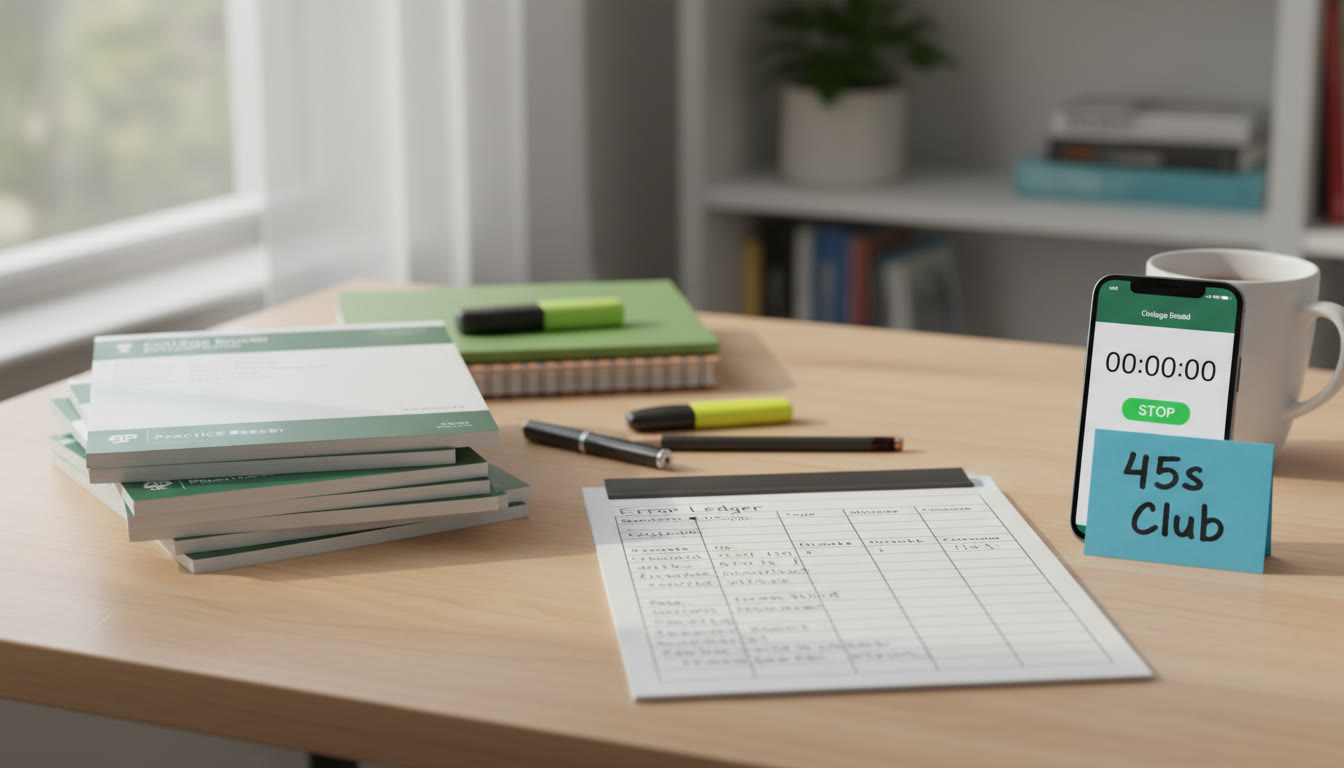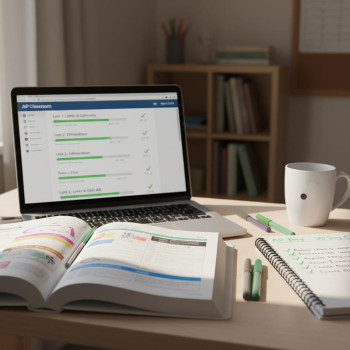Why timing matters: The quiet advantage of seconds
Imagine walking into your AP exam with a calm pulse and a plan: you know how long you’ll spend on each multiple-choice question, when you’ll mark and move on, and how to convert a small time edge into a higher score. That’s the power of a timing ladder—an intentional, progressive plan that trains you to answer AP multiple-choice questions faster and more accurately without panicking. This guide shows you how to realistically reduce your per-question time from roughly 90 seconds to 45 seconds through drills, micro-habits, and smart review.

What is a timing ladder?
A timing ladder is a progressive training schedule that reduces the time you allow yourself to answer multiple-choice questions in small, sustainable increments. Think of it like interval training for your brain: you build speed and endurance gradually so accuracy remains high as pace increases.
Why a ladder, not a sprint?
- Small steps preserve accuracy. Dropping too many seconds at once causes careless mistakes.
- It trains two skills simultaneously: speed (faster recognition and calculation) and rhythm (knowing when to move on).
- It’s psychologically easier—you win small victories each week, which builds confidence.
Start point: Where 90 seconds per question comes from
Many students begin practicing casually: read the stimulus, scribble work, re-check, and linger. That’s fine during learning, but the real exam favors efficient action. Depending on the AP subject and how many MCQs you’ll face, average available time per question ranges widely—some exams give more time for certain sections, some less. Starting at ~90 seconds gives you room to refine method and preserve accuracy while you condition speed.
Real-world math: What 90s vs 45s means
At 90 seconds per question, a 40-question section would take 60 minutes. Dropping to 45 seconds halves that time to 30 minutes—freeing up time for review or giving you a buffer on more complex items. That buffer can be the difference between a 3 and a 4, or a 4 and a 5.
How the ladder works: 8-week progressive plan
The ladder below is designed to be flexible: adapt week counts or session lengths to your school schedule. The core idea: reduce allowed time per question by a small step each week while keeping your accuracy target stable (aim >85% on practice at each rung before moving down).
| Week | Target Time per Question | Session Goal | Accuracy Goal (Practice) |
|---|---|---|---|
| 1 | 90 seconds | Complete 20 MCQs unrushed; note major time sinks | 90% |
| 2 | 75 seconds | Timed sets of 20; focus on elimination strategies | 88% |
| 3 | 65 seconds | Timed sets of 25; practice mental math shortcuts | 87% |
| 4 | 60 seconds | Set of 30; identify question types you slow on | 86% |
| 5 | 55 seconds | Mixed-topic 30 questions; practice quick checks | 86% |
| 6 | 50 seconds | Two sets of 30; simulate exam-style fatigue | 85% |
| 7 | 45 seconds | Full-section simulation at target pace | 85%+ |
| 8 | 45 seconds | Refine review strategy; targeted practice on weak items | 85%+ |
How to measure accuracy and when to repeat a rung
Do not drop pace permanently unless you hit the target accuracy for two consecutive timed sessions. If accuracy dips below the goal, repeat that week’s rung and add a technique focus: elimination practice, calculator fluency, or reading-for-clues drills.
Concrete drills that actually build speed
Speed without method is futile. Each drill below targets a specific bottleneck.
1) 5-Second Scan Drill (per question)
- Goal: Train your eyes to pull the relevant data quickly.
- Method: Look at one MCQ, spend exactly 5 seconds scanning the prompt and answers, note the main variable and what’s being asked, then close your eyes and state the goal aloud (or in your head).
- Benefit: Reduces wasted reading time and prevents re-reading.
2) Two-Choice Elimination Drill
- Goal: Practice eliminating two choices quickly to leave a 50/50.
- Method: For each practice question, spend no more than 30–40 seconds eliminating obviously wrong choices. If you can’t eliminate two, mark and come back.
- Benefit: Cuts complex decisions down to simpler guesses when necessary.
3) One-Minute Calculation Sprints
- Goal: Build arithmetic and algebraic fluency to reduce scratch work time.
- Method: Use a stack of 10 quick computation prompts (fractions, proportions, unit conversions) and complete them against a timer.
- Benefit: Less time lost to basic computation on the test.
4) Passage Mapping for Text-Based MCQs
- Goal: For AP English or social sciences, create tiny maps—one sentence summary of each paragraph in the margin in 10 seconds.
- Method: During practice, highlight or write a one-line summary for each paragraph. Over time, you’ll do this mentally.
- Benefit: Faster retrieval of evidence and less re-reading.
When to skip and when to stay: a decision protocol
On exam day, time is finite. Use a clear, pre-decided rule for skipping questions so you don’t waste mental energy on timing decisions.
- Rule 1 — 2-pass method: First pass: answer all questions you can in the target time. Second pass: return to marked questions using remaining time.
- Rule 2 — The 3-strike check: If after 75% of your allocated time for a question you haven’t found the answer and elimination hasn’t yielded a confident choice, mark and move on.
- Rule 3 — Smart guessing: When you must guess, eliminate at least one or two choices; don’t leave blanks.
Sample session: 60-minute MCQ block using the ladder
This realistic session shows how to translate the ladder into a weekly practice block you can fit between classes.
| Activity | Duration | Purpose |
|---|---|---|
| Warm-up computations (10 quick problems) | 10 min | Sharpen arithmetic and formulas |
| Timed set (30 MCQs) at target pace | 25–30 min | Build speed under simulated conditions |
| Focused review of missed items | 15 min | Fix patterns, not just answers |
| Reflection and note capture | 5–10 min | Plan specific drills for next session |
How to build review notes that actually reduce mistakes
After each session, capture three pieces of evidence for every mistake:
- The trap that fooled you (misread, arithmetic, misapplied rule).
- The rapid fix (a one-line reminder or mnemonic).
- A micro-drill you’ll use next session to prevent repeat errors.
Organize these into a one-page “error ledger” for the week. Over time you’ll find clusters—those clusters are high-leverage practice targets.
Examples and mini-case studies
Here are two quick profiles showing how different students use the ladder:
Case A — Maya, the late bloomer
Maya started with strong content knowledge but took 90–120s per question. She followed a 10-week ladder, emphasizing One-Minute Calculation Sprints and Two-Choice Elimination. By week 6 she hit 60s consistently; by week 9 she was reliably at 45s on most question types with accuracy above 85%. Her biggest win: she used the freed-up time to re-check 5 flagged items at the end of the section.
Case B — Ben, the analyst
Ben was overcautious and re-read prompts. His focus was the 5-Second Scan Drill and Passage Mapping. After four weeks, he cut reading time by 20–30s per question and could allocate more seconds to computation-heavy questions. His score improved mainly because he stopped changing correct answers on second reads.
Table: Quick reference — tactics by question type
| Question Type | Common Time Sink | Fast Strategy | Target Time |
|---|---|---|---|
| Pure computation (algebra, calc) | Fresh scratch work | Use mental arithmetic shortcuts + one-line setup | 40–60s |
| Graph/figure interpretation | Over-reading axis labels | Scan axes and legend first; highlight key numbers | 45–70s |
| Reading-based (English, History) | Re-reading full paragraphs | Passage mapping: 1-line summary per paragraph | 50–70s |
| Data sets or multi-part | Jumping between parts | Annotate data and answer in order of independence | 60–90s (break into sub-questions) |
How to integrate tutoring and tech without losing your rhythm
Personalized tutoring can accelerate the ladder—especially when tutors diagnose your timing leaks and give targeted drills. If you work with a 1-on-1 coach (for example, Sparkl’s personalized tutoring), ask them to:
- Observe a timed set and note your exact time sinks (reading, calculation, second-guessing).
- Build a tailored practice block that fits your curriculum and test date.
- Use AI-driven insights or progress reports to highlight stubborn error patterns so you can focus tiny drills on them.
Good tutoring is not about doing your practice for you; it’s about designing better practice and keeping you accountable as you shrink your per-question time.
Common pitfalls and how to avoid them
- Pitfall: Speed-first practice leads to sloppy errors. Fix: Keep strict accuracy goals before reducing time further.
- Pitfall: Changing too many variables at once (new timing + new question types). Fix: Isolate variables—work on timing with topics you already know well.
- Pitfall: Ignoring exam structure differences between subjects. Fix: Tailor the ladder to the subject’s real section times (some APs have calculator/no-calculator splits).
How to simulate exam conditions (and why it matters)
Simulate the exam at least three times before your test date: once early in the ladder (baseline), once mid-ladder (stress test), and once at the target 45s pace. For realistic simulation:
- Use official-style passages and question sets.
- Replicate breaks and calculator rules for that subject.
- Practice with the same tools (graphing calculator, ruler, Bluebook-like interface) and record your times.
When you hit the 45-second target: next moves
Once you can handle most question types at ~45 seconds with target accuracy, refine rather than reduce further. Do these five things:
- Polish elimination instincts so guessing is smarter.
- Practice triage—how much time to allocate to passage-heavy questions vs simple ones.
- Work on stamina—full-section practice under timed pressure.
- Keep a weekly micro-drill for your top two error types.
- Use a tutor or coach sparingly to diagnose last-5%-errors—sometimes a quick nudge from a pro or Sparkl’s expert tutor can remove a persistent blind spot.
A note on data and accuracy
Every AP subject has its own question counts and calculators/no-calculator splits; be sure to check your exam’s current structure and timing when planning. The ladder above is a general model that you should adapt to the actual timing of your specific AP exam.
Final checklist for your timing ladder
- Set a baseline: take a timed set at your current pace and log accuracy.
- Choose ladder length: 6–10 weeks depending on how much time you have before test day.
- Keep accuracy targets firm: don’t reduce time until you reliably hit the accuracy goal.
- Do one full simulated section under timed conditions at least three times.
- Use targeted micro-drills between sessions to fix repeated errors.
- Consider occasional 1-on-1 tutoring sessions to diagnose persistent issues—use them to refine, not replace, your practice.
Parting thought: small seconds, big gains
Dropping from 90 seconds to 45 seconds per question is not about rushing—it’s about disciplined practice, accurate self-observation, and smart decision rules. Time is a resource you can manage; when you do, you reduce stress, increase confidence, and create spare minutes to check the questions that matter. If you pair the ladder with focused tutoring or personalized feedback, you get a multiplier effect: faster learning plus better timing. Put the ladder on your calendar, stick to your accuracy goals, and celebrate the tiny improvements—those seconds add up to real score gains.

Want a printable starter plan?
Take the table from this article, adapt the weeks to your exam date, and print a single-page “timing ladder” to tape inside your binder. If you’d like tailored guidance, a short series of 1-on-1 sessions with an expert tutor—especially one who tracks your progress and designs micro-drills—can compress the ladder timeline safely. Sparkl’s personalized tutoring approach (targeted practice blocks, expert tutors, and AI-driven insight into error patterns) is a natural fit for students who want a structured path and accountability without losing ownership of their practice.
Ready to climb?
Start today: pick one timed session, log your baseline, and pick the first rung that feels challenging but achievable. Small, consistent steps win this race. Good luck—your future self will thank you for every second well trained.



















No Comments
Leave a comment Cancel